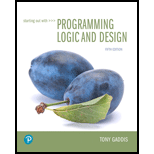
Concept explainers
A ______ controlled loop uses a true/false condition to control the number of times that it repeats.
- a. Boolean
- b. condition
- c. decision
- d. count
The “while” loop is a condition controlled loop, it controls the number of times that repeats.
Hence, the correct answer is option “B”.
Explanation of Solution
Condition controlled loop:
This is a loop which exhibits true or false condition to control the number of times that the loop repeats. For example: “while” loop is a condition controlled loop.
- The “while” loop first checks its expression and then, the statements inside the loop gets executed. It is also called as pretest loops.
- The loop gets terminated when the condition becomes false.
Syntax:
Syntax for the “while” loop is as follows:
while boolean_expression:
# while suite
Example Program:
Consider the following example of condition controlled loop:
#initialization of variable
a=1
#execute the while loop until a is less than or equal to 5
while a<=5:
#Print the value of a
print(a)
#Increment a by 1 for each iteration of loop
a+=1
Explanation:
In the above code, the “while” loop executes until the value of “a” is less than or equal to 5 and then it exits from the program when the condition inside the loop gets failed.
Explanation of incorrect options:
Boolean:
Boolean is not a loop instead it is a data type which is represented with two values either true or false. This value is based upon the flow of the action performed by the program.
Hence, the option “A” is wrong.
Decision:
A decision is not a loop and it decides the case to be executed based upon the situation.
Hence, the option “C” is wrong.
Count:
This is a loop which repeats specific number of times and it keeps track of the counter variable to keeps track about the number of times that the loop executes. For example: “for” loop is a counter controlled loop.
Hence, the option “D” is wrong.
1
2
3
4
5
Want to see more full solutions like this?
Chapter 5 Solutions
Starting Out with Programming Logic and Design (5th Edition) (What's New in Computer Science)
Additional Engineering Textbook Solutions
Database Concepts (8th Edition)
Management Information Systems: Managing The Digital Firm (16th Edition)
Starting Out with Java: From Control Structures through Objects (7th Edition) (What's New in Computer Science)
Modern Database Management
Web Development and Design Foundations with HTML5 (8th Edition)
Electric Circuits. (11th Edition)
- 2:21 m Ο 21% AlmaNet WE ARE HIRING Experienced Freshers Salesforce Platform Developer APPLY NOW SEND YOUR CV: Email: hr.almanet@gmail.com Contact: +91 6264643660 Visit: www.almanet.in Locations: India, USA, UK, Vietnam (Remote & Hybrid Options Available)arrow_forwardProvide a detailed explanation of the architecture on the diagramarrow_forwardhello please explain the architecture in the diagram below. thanks youarrow_forward
- Complete the JavaScript function addPixels () to calculate the sum of pixelAmount and the given element's cssProperty value, and return the new "px" value. Ex: If helloElem's width is 150px, then calling addPixels (hello Elem, "width", 50) should return 150px + 50px = "200px". SHOW EXPECTED HTML JavaScript 1 function addPixels (element, cssProperty, pixelAmount) { 2 3 /* Your solution goes here *1 4 } 5 6 const helloElem = document.querySelector("# helloMessage"); 7 const newVal = addPixels (helloElem, "width", 50); 8 helloElem.style.setProperty("width", newVal); [arrow_forwardSolve in MATLABarrow_forwardHello please look at the attached picture. I need an detailed explanation of the architecturearrow_forward
- Information Security Risk and Vulnerability Assessment 1- Which TCP/IP protocol is used to convert the IP address to the Mac address? Explain 2-What popular switch feature allows you to create communication boundaries between systems connected to the switch3- what types of vulnerability directly related to the programmer of the software?4- Who ensures the entity implements appropriate security controls to protect an asset? Please do not use AI and add refrencearrow_forwardFind the voltage V0 across the 4K resistor using the mesh method or nodal analysis. Note: I have already simulated it and the value it should give is -1.714Varrow_forwardResolver por superposicionarrow_forward
- Describe three (3) Multiplexing techniques common for fiber optic linksarrow_forwardCould you help me to know features of the following concepts: - commercial CA - memory integrity - WMI filterarrow_forwardBriefly describe the issues involved in using ATM technology in Local Area Networksarrow_forward
 EBK JAVA PROGRAMMINGComputer ScienceISBN:9781337671385Author:FARRELLPublisher:CENGAGE LEARNING - CONSIGNMENT
EBK JAVA PROGRAMMINGComputer ScienceISBN:9781337671385Author:FARRELLPublisher:CENGAGE LEARNING - CONSIGNMENT Microsoft Visual C#Computer ScienceISBN:9781337102100Author:Joyce, Farrell.Publisher:Cengage Learning,Programming Logic & Design ComprehensiveComputer ScienceISBN:9781337669405Author:FARRELLPublisher:Cengage
Microsoft Visual C#Computer ScienceISBN:9781337102100Author:Joyce, Farrell.Publisher:Cengage Learning,Programming Logic & Design ComprehensiveComputer ScienceISBN:9781337669405Author:FARRELLPublisher:Cengage C++ for Engineers and ScientistsComputer ScienceISBN:9781133187844Author:Bronson, Gary J.Publisher:Course Technology Ptr
C++ for Engineers and ScientistsComputer ScienceISBN:9781133187844Author:Bronson, Gary J.Publisher:Course Technology Ptr C++ Programming: From Problem Analysis to Program...Computer ScienceISBN:9781337102087Author:D. S. MalikPublisher:Cengage Learning
C++ Programming: From Problem Analysis to Program...Computer ScienceISBN:9781337102087Author:D. S. MalikPublisher:Cengage Learning Programming with Microsoft Visual Basic 2017Computer ScienceISBN:9781337102124Author:Diane ZakPublisher:Cengage Learning
Programming with Microsoft Visual Basic 2017Computer ScienceISBN:9781337102124Author:Diane ZakPublisher:Cengage Learning





